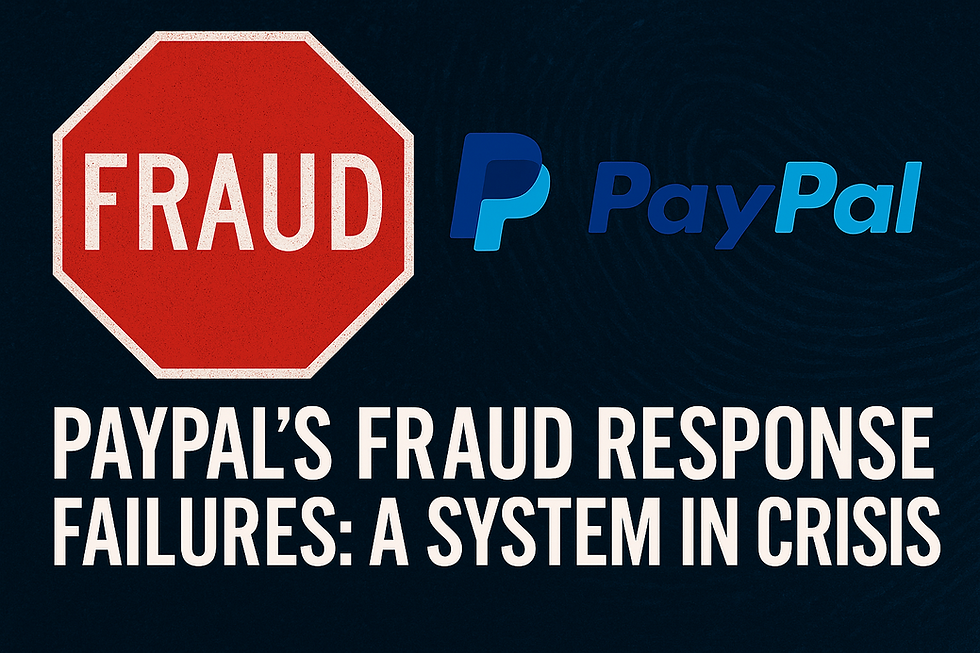PayPal’s Fraud Response Failures: A System in Crisis
- Dr. Wil Rodriguez

- Jul 20
- 5 min read
By Dr. Wil Rodriguez
Tocsin Magazine

The Promise vs. The Reality
PayPal markets itself as a secure, reliable payment platform that protects users from fraud and unauthorized transactions. The company’s official policies promise timely responses to fraud reports, comprehensive investigations, and fair resolution processes. However, mounting evidence suggests a troubling gap between these promises and the actual experience of fraud victims.
The Current State of PayPal’s Fraud Response System
According to PayPal’s own guidelines, the company aims to respond to payment-related claims within 15 days, with other claims potentially taking up to a month. They promise to send acknowledgment receipts within 10 days and conduct thorough evaluations typically lasting 30 days, though complex cases may require more time.
Yet these timeframes appear to be more aspirational than realistic. Countless users report waiting weeks or even months for any response whatsoever, despite providing comprehensive evidence and making multiple follow-up attempts.
A Pattern of Systemic Failures
The Silent Treatment
One of the most disturbing trends is PayPal’s tendency to simply ignore fraud reports entirely. Users describe submitting detailed evidence packages—screenshots, email chains, transaction records, witness statements—only to receive complete radio silence from the company. This isn’t merely a delay; it’s a complete absence of acknowledgment that a report was even received.
The Endless Loop of Customer Service
When fraud victims attempt to follow up through PayPal’s customer service channels, they encounter a system that seems designed to exhaust rather than assist. Representatives frequently claim they cannot access case information, promise callbacks that never materialize, or provide conflicting information about case status. Users report making dozens of calls with no progress whatsoever.
Evidence That Disappears Into the Void
Perhaps most frustrating is the apparent disregard for user-submitted evidence. Fraud victims meticulously document their cases, providing clear proof of scams, unauthorized transactions, and deceptive practices. Yet these comprehensive evidence packages seem to vanish into PayPal’s system without any indication they’ve been reviewed by human investigators.
The Automation Problem
Many patterns suggest that PayPal has increasingly relied on automated systems to handle fraud reports, with minimal human oversight. This algorithmic approach may work for simple, clear-cut cases, but it fundamentally fails when dealing with sophisticated scams or complex fraud scenarios that require nuanced investigation.
Automated systems cannot:
Evaluate the credibility of submitted evidence
Understand the context of unusual transactions
Recognize new or evolving fraud techniques
Provide meaningful communication to affected users
Make judgment calls in ambiguous situations
Real-World Consequences
The impact of these systemic failures extends far beyond mere inconvenience:
Financial Losses: Users lose money to scammers with no recourse
Destroyed Trust: Faith in digital payment systems erodes
Time Waste: Countless hours spent trying to get basic responses
Emotional Stress: Victims face additional trauma from institutional indifference
Business Impact: Legitimate businesses suffer from inadequate fraud protection
The Dispute Fee Scandal
Adding insult to injury, PayPal charges dispute fees to sellers who experience high dispute rates. This creates a perverse incentive structure where the company profits from fraud disputes while potentially discouraging thorough investigations. Sellers with dispute rates of 1.5% or higher face additional fees, creating financial pressure to simply accept fraudulent transactions rather than fight them.
Regulatory Gaps and Accountability
Unlike traditional banks, which face strict regulatory oversight for fraud response procedures, PayPal operates in a regulatory gray area. This lack of oversight may contribute to the company’s apparent indifference to fraud victims’ experiences. Without mandatory response times, investigation standards, or customer service requirements, PayPal faces little pressure to improve its fraud response systems.
Common Fraud Types PayPal Fails to Address
Current data shows that PayPal struggles particularly with:
Account Takeover Scams: False problem notifications that lead to account compromise
Seller Protection Failures: Legitimate sellers losing money when buyers claim unauthorized transactions
Phishing Evolution: Sophisticated email scams that bypass PayPal’s detection systems
Social Engineering: Complex scams that exploit human psychology rather than technical vulnerabilities
A System That Protects the Platform, Not the Users
Evidence suggests that PayPal’s current approach prioritizes protecting the company’s interests over user welfare. By maintaining a deliberately slow, unresponsive fraud investigation process, PayPal may be:
Reducing operational costs by discouraging reports
Limiting liability exposure through delayed responses
Avoiding setting precedents for comprehensive fraud protection
Maintaining plausible deniability about systematic problems
The Need for Reform
PayPal’s fraud response failures represent more than customer service problems—they indicate fundamental flaws in how digital payment platforms approach user protection. Reform is urgently needed in several areas:
Mandatory Response Times: Clear, enforceable deadlines for fraud report acknowledgment and investigation
Human Review Requirements: Guarantees that complex cases receive human attention, not just algorithmic processing
Evidence Standards: Clear criteria for what constitutes adequate investigation of user-submitted evidence
Transparency Requirements: Regular reporting on fraud response statistics and outcomes
Regulatory Oversight: Government involvement in establishing minimum standards for fraud protection
What Users Can Do Now
While awaiting systemic reform, fraud victims have limited but important options:
File formal complaints with consumer protection agencies
Document all interactions meticulously for potential legal action
Escalate cases through business dispute resolution services
Share experiences publicly to raise awareness
Consider alternative payment platforms with better fraud protection records
Conclusion
PayPal’s fraud response system is failing the millions of users who depend on the platform for secure transactions. The company’s promises of protection ring hollow when fraud victims face weeks or months of silence, despite providing comprehensive evidence of criminal activity.
This isn’t simply a customer service problem—it’s a fundamental failure to fulfill the basic trust relationship that underpins all financial services. PayPal has built a global empire on the promise of secure, protected transactions. When that protection fails, and when the company refuses to even acknowledge that failure, it betrays not just individual users but the entire digital economy that depends on reliable payment systems.
The time has come for PayPal to acknowledge these systematic failures and implement meaningful reforms. Until then, users must navigate a system that too often protects everyone except the people who need protection most: the victims of fraud.
Call to Action
If you’ve experienced fraud through PayPal, your voice matters. Document your case, share your story, and demand accountability. Contact your local consumer protection agency and consider switching to payment platforms with proven records of user protection. Collective pressure can drive reform—be part of the change.
💬 Author Reflection
Writing this article was not an exercise in criticism, but in advocacy. I’ve spoken with real people—business owners, students, caregivers—who were devastated not only by fraud, but by PayPal’s silence. Their frustration is not just about money—it’s about feeling abandoned by a system they trusted. I believe accountability begins with truth-telling, and my aim here is to amplify the voices that have too often gone unheard.
Join the TOCSIN Movement
Explore more investigative articles, cultural critiques, and bold voices exposing the systems that shape (and fail) our everyday lives. At TOCSIN Magazine, we’re not just observing—we’re sounding the alarm.
Visit tocsinmag.com and become part of a movement that dares to ask the difficult questions.







Comments